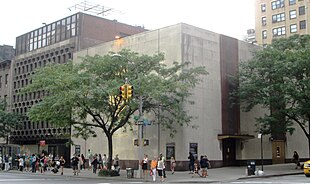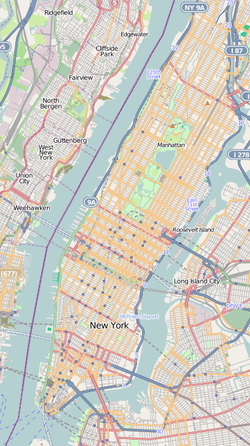| Temple Shaaray Tefila | |
|---|---|
| Hebrew: שערי תפילה | |
 The synagogue from the northeastern corner of East 79th Street and 2nd Avenue The synagogue from the northeastern corner of East 79th Street and 2nd Avenue | |
| Religion | |
| Affiliation | Reform Judaism |
| Ecclesiastical or organisational status | Synagogue |
| Leadership |
|
| Status | Active |
| Location | |
| Location | 250 East 79th Street, Upper East Side, Manhattan, New York City, New York 10075 |
| Country | United States |
 | |
| Geographic coordinates | 40°46′24″N 73°57′20″W / 40.773357°N 73.955463°W / 40.773357; -73.955463 |
| Architecture | |
| Architect(s) | Wooster Street:
|
| Type | Synagogue |
| Date established | 1845 (as a congregation) |
| Completed |
|
| Construction cost | $1.5 million ($15.8 million today) |
| Website | |
| shaaraytefilanyc | |
Temple Shaaray Tefila (Hebrew: שערי תפילה, lit. 'Gates of Prayer') is a Reform Jewish synagogue located at 250 East 79th Street (at the corner of 2nd Avenue) on the Upper East Side of Manhattan in New York City, New York, United States.
The synagogue was founded in 1845, and was officially chartered in 1848. It moved to its current location in 1959. It has over 1,200 family member units, and over 800 students combined in its religious school and early childhood programs.
History
The synagogue was founded in 1845 by 50 primarily English and Dutch Jews who had been members of B'nai Jeshurun, and was officially chartered in 1848. It was initially an Orthodox synagogue. It slowly turned to Reform Judaism over the years.
By 1862 it had 200 members. In 1865, it opened its religious school. In 1871, it consolidated with the Beth-El congregation, which had been organized in 1853.
The services were modified to a shorter, simpler version in 1879. Some of the material was presented in English. That was followed by the synagogue allowing men and women to sit together, introducing organ music and a mixed choir. In 1901, it had 240 members. In 1902, the congregation joined the Reform movement's national organization of congregations, the Organization of American Hebrew Congregations. By 1916, it had 500 members.
In 1921, the synagogue joined the American Reform movement – the Union of American Hebrew Congregations (or UAHC, now the URJ).

In 1993, it established a nursery school for children 2.5 to 5 years of age. In 1996, the corner of East 79th Street and 2nd Avenue at which it sits was designated Temple Shaaray Tefila Place, in celebration of the congregation's 150th anniversary.
Locations
It was initially located on Wooster Street. The synagogue relocated in turn to West 34th Street, West 36th Street, West 44th Street (and Sixth Avenue), and 160 West 82nd Street (near Amsterdam Avenue; where it began to be referred to as West End Synagogue).
In 1958 it purchased land and began construction, and in 1959 it completed construction and moved to its current Upper East Side location at 250 East 79th Street and 2nd Avenue, a theater converted at a cost of $1,500,000 ($15,800,000 in current dollar terms).
Rabbis
The synagogue's first rabbi was Samuel Isaacs, who spoke English, one of only a few such rabbis in the United States. He was a firm adherent of Orthodox Judaism, and retired in 1877. His funeral at the synagogue the following year was the largest Jewish funeral of the nineteenth century.
Beginning in 1877, it was led by Rabbi Frederick de Sola Mendes (who also became the first Chairman of the YMHA during his tenure), and from 1920, it was led by Rabbi Nathan Stern.
Rabbi Bernard Bamberger was the rabbi from 1944 until 1971. He also served as President of the Central Conference of American Rabbis, as well as the World Union for Progressive Judaism.
Rabbi Philip Schechter was then rabbi at the synagogue for a short time. He was fired in February 1971 by a vote of 144–135 of synagogue members 35 years of age and older, when his reforms to the liturgy and loosening of the dress code were not well received by some members of the congregation. He was followed by Senior Rabbi Harvey Tattelbaum, who led the synagogue for three decades, until 2001 when he became Rabbi Emeritus.
Rabbi Jonathan Stein became Senior Rabbi in July 2001, and served until June 2014. He had previously been Senior Rabbi of both Congregation Beth Israel of San Diego and Indianapolis Hebrew Congregation. He also became President of the Central Conference of American Rabbis in March 2011, for a two-year term. As President, he led the principal organization of Reform rabbis in the U.S. and Canada. Following Rabbi Stein's retirement in June 2014, the Board of Trustees appointed Rabbi Deborah Hirsch as the Interim Senior Rabbi, while the Board searched for a senior rabbi replacement.
On February 4, 2016, the congregation unanimously elected Rabbi Joel Mosbacher as Senior Rabbi beginning July 1, 2016. In July 2018, Rabbi Sarah Reines joined the congregation as a rabbi and left in 2022. Rabbi Jill Rubin joined the clergy in August 2022 and currently serves as Associate Rabbi.
Notable members
- Bernard Baruch (1870–1965), financier, stock investor, philanthropist, statesman, and political consultant
- Charles S. Bernheimer (1868–1960), American social worker, served as president of the synagogue
- Sandy Fong (born 1990), finished 21st in the 2008 Summer Olympics 50 metre rifle three positions shooting event
- Leon Klinghoffer (1916–85), disabled appliance manufacturer who was murdered and thrown overboard by Palestinian terrorists hijacking the cruise ship Achille Lauro in 1985; his 800-person funeral was held at the synagogue
- William Schuman (1910–92), composer and music administrator, attended as a child
- Alan V. Tishman (1917–2004), real estate developer, funeral
References
- ^ "Shaaray Tefila Jubilee – The congregation a vigorous child of B'nai Jeshurun". The New York Times. March 21, 1896. Retrieved January 7, 2013.
- ^ "Our History and Vision". Temple Shaaray Tefila. Archived from the original on January 24, 2013. Retrieved May 15, 2016.
- ^ Olitzky, Rabbi Kerry M.; Raphael, Marc Lee (1996). The American Synagogue: A Historical Dictionary and Sourcebook. Greenwood Publishing Group. ISBN 9780313288562. Retrieved January 7, 2013.
- Goldman, Victoria (2012). The Manhattan Directory of Private Nursery Schools (7th ed.). Soho Press. ISBN 9781616950521. Retrieved January 7, 2013.
- "Temple Shaaray Tefila Nursery School". New York Magazine. October 13, 1969. Retrieved January 7, 2013.
- Feirstein, Sanna (2001). Naming New York: Manhattan Places & How They Got Their Names. New York: New York University Press. p. 132. ISBN 978-0-8147-2712-6.
- "Synagogue rededicated". The New York Times. December 18, 1937. Retrieved January 7, 2013.
- "Shaaray Tefila to open temple". The New York Times. September 19, 1959. Retrieved January 7, 2013.
- Swierenga, Robert P. (1994). The Forerunners: Dutch Jewry in the North American Diaspora. Wayne State University Press. p. 86. ISBN 0814324339. Retrieved January 7, 2013.
Temple Shaaray Tefila.
- Kaufman, David (1999). Shul With a Pool: The "Synagogue-Center" in American Jewish History. UPNE. ISBN 9780874518931. Retrieved January 7, 2013.
- Kravitz, Leonard S.; Olitzsky, Rabbi Kerry M. (1993). Pirke Avot: A Modern Commentary on Jewish Ethics. URJ Books and Music. ISBN 9780807404805. Retrieved January 7, 2013.
- ^ "Long-haired N.Y. Rabbi Sees Exodus of Young People to New Temple". St. Joseph Gazette. February 18, 1971. Retrieved January 7, 2013.
- ^ "Rabbi Deborah A. Hirsch, Interim Senior Rabbi". Temple Shaaray Tefila.
- "Rabbi Mosbacher's address to Shaaray Tefila". Temple Shaaray Tefila. February 4, 2016. Retrieved February 25, 2016.
- "Rabbi Sarah Reines". Temple Shaaray Tefila. Retrieved November 1, 2020.
- "Rabbi Jill Rubin". Temple Shaaray Tefila.
- Phillips, Mccandlish (June 24, 1965). "700 Attend Baruch Funeral at Family Synagogue – Family Joined by Dignitaries at 15-Minute Rites Here for Financier". The New York Times. Retrieved January 7, 2013.
- Simons, John, ed. (1938). Who's Who in American Jewry, 1938–1939. Vol. 3. National News Association, Inc. pp. 86–87 – via FamilySearch.
- Lipman, Steve (August 22, 2008). "Yuman Fong". The Jewish Week. Archived from the original on March 4, 2016. Retrieved January 7, 2013.
- Bohn, Michael K. (2004). The Achille Lauro Hijacking. Potomac Books, Inc. ISBN 9781612342757. Retrieved January 7, 2013.
- Swayne, Steve (2011). Orpheus in Manhattan: William Schuman and the Shaping of America's Musical Life. Oxford University Press. p. 29. ISBN 9780199793105. Retrieved January 7, 2013.
Temple Shaaray Tefila.
- "Paid Notice: Deaths Tishman, Alan Valentine". The New York Times. January 15, 2004.
Further reading
- Cohen, Simon (1945). Shaaray Tefila: a history of its hundred years, 1845–1945. Greenberg – via Google Books.
External links
| By state | |||||||||||||
| Alabama | |||||||||||||
| Arizona | |||||||||||||
| Arkansas | |||||||||||||
| California |
| ||||||||||||
| Colorado | |||||||||||||
| Connecticut | |||||||||||||
| District of Columbia | |||||||||||||
| Florida | |||||||||||||
| Georgia | |||||||||||||
| Hawaii | |||||||||||||
| Idaho | |||||||||||||
| Illinois |
| ||||||||||||
| Indiana | |||||||||||||
| Iowa | |||||||||||||
| Kansas | |||||||||||||
| Kentucky | |||||||||||||
| Louisiana | |||||||||||||
| Maine | |||||||||||||
| Maryland |
| ||||||||||||
| Massachusetts |
| ||||||||||||
| Michigan | |||||||||||||
| Minnesota | |||||||||||||
| Mississippi | |||||||||||||
| Missouri | |||||||||||||
| Nebraska | |||||||||||||
| New Jersey |
| ||||||||||||
| New Mexico | |||||||||||||
| New York |
| ||||||||||||
| North Carolina | |||||||||||||
| North Dakota | |||||||||||||
| Ohio |
| ||||||||||||
| Oklahoma | |||||||||||||
| Oregon | |||||||||||||
| Pennsylvania |
| ||||||||||||
| Rhode Island | |||||||||||||
| South Carolina | |||||||||||||
| Tennessee | |||||||||||||
| Texas | |||||||||||||
| Utah | |||||||||||||
| Vermont | |||||||||||||
| Virginia | |||||||||||||
| Washington | |||||||||||||
| West Virginia | |||||||||||||
| Wisconsin | |||||||||||||
| Wyoming | |||||||||||||
| Territories | |||||||||||||
- 1845 establishments in New York (state)
- 20th-century synagogues in the United States
- Dutch-Jewish culture in the United States
- English-Jewish culture in the United States
- Jewish organizations established in 1845
- Reform synagogues in New York City
- Synagogues completed in 1959
- Synagogues in Manhattan
- Upper East Side
- Second Avenue (Manhattan)